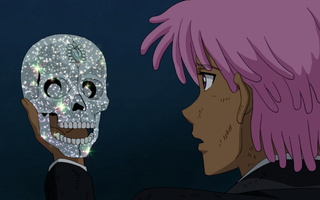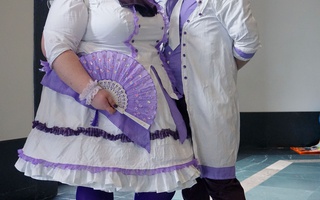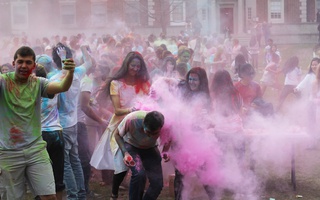{shortcode-a100734bd8667a109ec4e8ee0f1087019d4581ff}On the fifth day, I took out a scrap of paper and wrote down all the thoughts in my head:
1. The limbo between fantasy and reality. The violence that fantasy inflicts upon reality—That’s what I shall explore (as an individual and as an artist).
2. Neither happy nor sad, neither passionate nor cold—the feeling that I sometimes explain to people as daydreaming but is really more like dreamless sleep: It makes me feel like a container holding a secret that I’ll never understand.
3. Film idea: A man stops speaking, because he doesn’t know what he really wants to say and who he wants to say it to. After twenty years he breaks the silence (Why now?).
4. Another film idea: A girl wakes up and realizes the door of her room has disappeared. In complete solitude, she ponders (What does she do?).
I read the list twice, added a fifth item, and crossed it out. Then I thought about “Neon Genesis Evangelion,” an anime I watched when I was 12, in which giant robots fight mysterious monsters that try to destroy our world. The protagonist is a 14-year-old boy, one of the few gifted teens who can operate the robots. He is sensitive and averse to violence, and fighting leaves him with deep trauma, but he has to continue because humanity is counting on him to defeat the monsters. By the end of the story, he has achieved the power to decide the fate of the world. Depressed, disillusioned, and disheartened by his failed attempts at forming relationships, he chooses to destroy everything and everyone. Halfway through the destruction, he realizes that he can’t let go of the people he loves, even after they have hurt him. So he stops, and he and the girl he loves are left alone, the last humans on the planet.
I realized that all of my filmic preferences and explorations could be traced back to this anime. The intense, destructive romanticism that I relished in Jean-Luc Godard and Leos Carax, the aestheticization of isolation that I admired in Wong Kar-wai and Chantal Akerman, and even the blending of subjective and objective reality I saw in Andrei Tarkovsky are all things I first experienced watching “Evangelion” ten years ago. I was 22 now, but nothing had changed.
I wondered if I should go to Social Room. Maybe there would be 100 other guys she had picked up at Vietnamese restaurants. Maybe I’d spend the night pretending that the reason I was standing by myself was that I was too cool to talk to people. I stared at the fan on the ceiling. What the hell, I would just get drunk beforehand, and I wouldn’t care about any of that.
I did go, and I did go drunk. The club was literally a studio room in an apartment building off of Lan Kwai Fong, but there was great techno. When I walked in, she immediately saw me and introduced me to her group as an artist friend. It turned out that they were all friends with the DJ. The blue lights in the club were flashing intensely. I said that I loved this DJ’s music, and she suggested we all shut the fuck up and go dance.
On the dance floor I started to really consider her appearance for the first time. Her sparkling grey dress flew in space while she danced effortlessly. She made sure to engage both of her male friends. I guessed that she was one of those people who works at a big corporation but knows a lot about the underground club scene. I started twirling my head aggressively. I was jumping around more than I was dancing. The alcohol made me warm, and I felt I had enough energy to fill the room, so I just did whatever I felt like doing. She looked at me with encouragement, and her friends were cheering. They were all very nice people. I bounced back and forth, sometimes into them. The trippy projection behind the stage had become a blur, and the techno was pounding hard. I realized I still didn’t even know her name.
At 3 AM we all took the death bus back to Mong Kok. Death buses are night-time vehicles that tremble hard and run across the city like San Fermin bulls. They get their name from their adrenaline-producing sharp turns and reckless speeds. Due to public safety concerns, the government mandated speed meters that would beep if the shuttles’ speeds exceeded 80 kilometers, so that passengers could report drivers who topped this limit. But nobody wanted to sacrifice convenience for safety, so the only result was the addition of continuous beeping to the incessant trembling. As we beeped through the tunnel across Victoria Harbour, she told me her name was Kwan Yin.
“Like the Buddha,” she said.
I watched her lips move, and imagined how they would change shape if I pressed mine against them. I imagined feeling the weight and warmth of her body in my arms, and in my mind I saw my arms move through the trajectories that would make that happen. She was still talking to me, now about another club. I decided to continue to indulge my imagination, discretely and silently. It is incredible how two people can sit side by side and each have no clue what is on the other’s mind.
—Staff writer Tianxing V. Lan's column, "3AM Cinema Club," is a serialized work of fiction set in Hong Kong which follows the protagonist as he works to write a screenplay.
Read more in Arts
‘The Joel McHale Show’’s Topical Potential Is Undermined by Shoddy Writing and Annoying MarketingRecommended Articles
-
POPSCREEN: Britney SpearsBritney’s music videos are like an ever-rotating menu of fantasies, but after 10 years of Britney (“...Baby One More Time”
-
 ‘Neo Yokio’: When Tweets Become TV
‘Neo Yokio’: When Tweets Become TV -
 How One Blockchain’s Vision and Technology Separates Them from the Pack
How One Blockchain’s Vision and Technology Separates Them from the Pack -
 Armor and Art at Anime Boston
Armor and Art at Anime Boston -
 This Week in Photos: Apr. 2 - Apr. 6
This Week in Photos: Apr. 2 - Apr. 6













